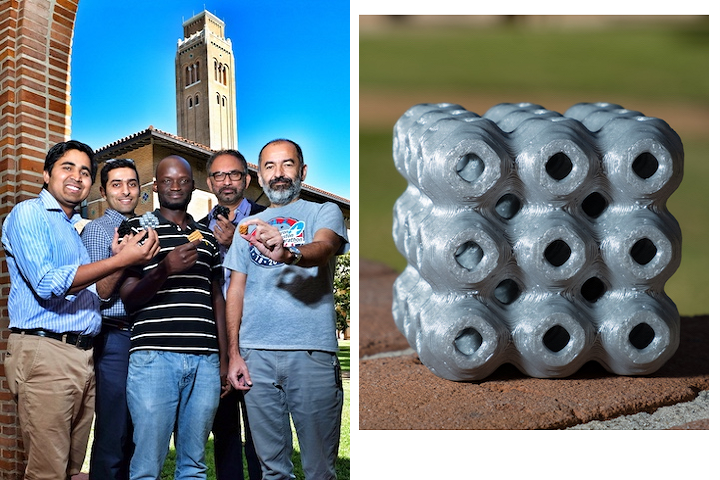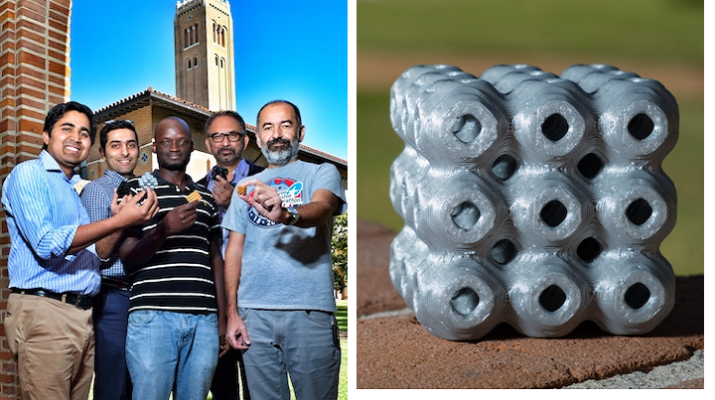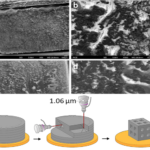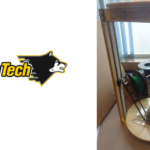
 We’ve seen math and 3D printing technology combined before, whether it’s designing and 3D printing a math-inspired dress or high-tech sculpture, helping young students understand fundamental and complex mathematics, creating three-dimensional fractal forms, or gaining a better understanding of the geometry of the trefoil knot design. Now, engineers and researchers from Rice University and the University of Campinas, São Paulo, are using 3D printing to turn mostly theoretical structures into strong, lightweight objects, with repeating and complex patterns, known as schwarzites. Computer algorithms are typically used to design the porous structures, but the team was able to send 3D printable data from these programs to create durable, polymer models on the macroscale. The researchers then tested the mathematical models, which they attempted to make with as little material as they could, while still maintaining their compressability and strength.
We’ve seen math and 3D printing technology combined before, whether it’s designing and 3D printing a math-inspired dress or high-tech sculpture, helping young students understand fundamental and complex mathematics, creating three-dimensional fractal forms, or gaining a better understanding of the geometry of the trefoil knot design. Now, engineers and researchers from Rice University and the University of Campinas, São Paulo, are using 3D printing to turn mostly theoretical structures into strong, lightweight objects, with repeating and complex patterns, known as schwarzites. Computer algorithms are typically used to design the porous structures, but the team was able to send 3D printable data from these programs to create durable, polymer models on the macroscale. The researchers then tested the mathematical models, which they attempted to make with as little material as they could, while still maintaining their compressability and strength.
Schwarzites are named for Hermann Schwarz, the German scientist who first hypothesized their existence back in the 1880s. The structures are described as “mathematical marvels,” and have provided inspiration for many other organic and inorganic materials and constructs. Until this team decided to work on designing 3D forms from 2D surfaces and succeeded in using 3D printing as a practical means of manufacturing schwarzites, the structure was only theoretical.
The researchers used molecular dynamics simulations to investigate the structures’ bottom-up construction, and later 3D printed the simulations in polymer cube form.
Chandra Sekhar Tiwary, a Rice postdoctoral researcher, said, “The geometries of these are really complex; everything is curved, the internal surfaces have negative curvature and the morphologies are very interesting.
Schwarzite structures are very much the same. The theory shows that at the atomic scale, these materials can be very strong. It turns out that making the geometry bigger with polymer gives us a material with a high load-bearing capacity.”
Additionally, schwarzites also have great deformation characteristics.
“The way a material breaks is important. You don’t want things to break catastrophically; you want them to break slowly. These structures are beautiful because if you apply force to one side, they deform slowly, layer by layer,” Tiwary said. “You can make a whole building out of this material, and if something falls on it, it’s going to collapse slowly, so what’s inside will be protected.”

The researchers published the results in an article, titled “Multiscale Geometric Design Principles Applied to 3D Printed Schwarzites,” in Advanced Materials; co-authors include Seyed Mohammad Sajadi, Peter Samora Owuor, Steven Schara, Cristiano Woellner, Varlei Rodrigues, Robert Vajtai, Jun Lou, Douglas S. Galvão, Tiwary, and Pulickel M. Ajayan. The team only tested schwarzites 3D printed in primitive and gyroid structures, though they can take multiple forms, because they have periodic minimal surfaces – a quality first thought of by Schwarz himself.
Both of these 3D printed schwarzite structures were able to transfer loads across the whole geometry in tests, regardless of which side was compressed.
University of Campinas professor Galvão, who uses molecular dynamics simulations to study nanostructures, said, “It is a little surprising that some atomic-scale features are preserved in the printed structures. We discussed that it would be nice if we could translate schwarzite atomic models into 3-D printed structures. After some tentatives, it worked quite well. This paper is a good example of an effective theory-experiment collaboration.”
The results of the team’s work with 3D printed schwarzite structures could one day result in battery components, catalysts, molecular sieves, and nanoscale electronic devices; they could even become high-load-bearing, impact-resistant components on the macroscale for aircraft, automobiles, and buildings; the researchers even said that in the future, they could 3D print a whole building as a single schwarzite brick.
The next step will be using 3D printers with higher resolutions to refine the surfaces of the schwarzite structures, which will make the blocks even more lightweight by reducing the amount of polymer used. Way in the future, the researchers are hoping to 3D print schwarzites on a much larger scale, with metallic and ceramic materials.
Owuor said, “There’s no reason these have to be blocks. We’re basically making perfect crystals that start with a single cell that we can replicate in all directions.”
Discuss this and other 3D printing topics at 3DPrintBoard.com or share your thoughts in the Facebook comments below.
[Sources: Nanowerk, Rice University]
When it comes to 3D real estate visualization in the USA, our service provides the perfect solution for bringing property listings to life. Through our platform, you can easily access cutting-edge 3D renderings that showcase your real estate projects in a way that attracts potential buyers and investors. Whether it's residential, commercial, or mixed-use properties, our team of experts uses advanced technology to create immersive visualizations that highlight the best features of your property, making it easier for clients to imagine the space as their own.
Through our website, you can quickly get high-quality 3D real estate visualizations that are tailored to your specific needs. With our help, you'll stand out in the competitive real estate market by offering potential buyers a realistic, interactive view of your property. Our efficient process ensures a fast turnaround time, while our attention to detail guarantees that every aspect of the property is represented accurately, giving you a powerful marketing tool to promote your real estate listings.






